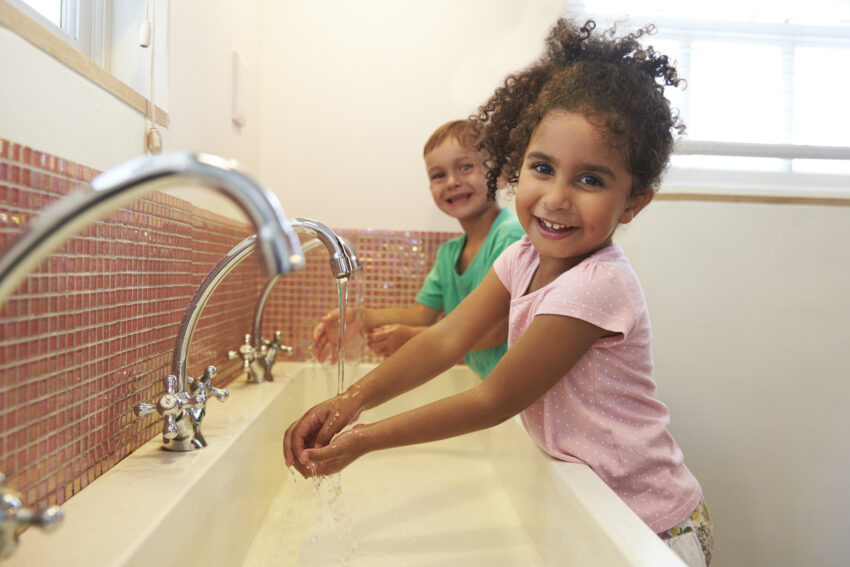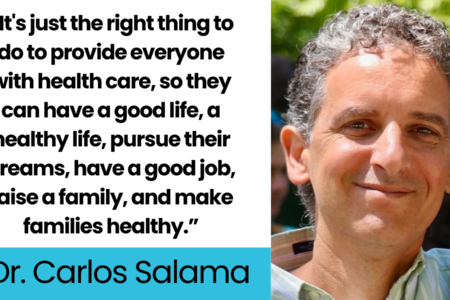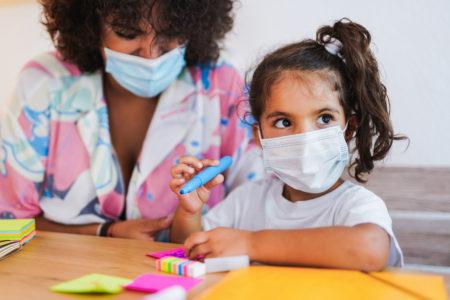
Share On Social!
Keeping kids clean and healthy at school can be a challenge.
Not only do you need to consider how and when to clean an educational environment, but also make sure that cleaning supplies are safely marked and stored.
That’s why the U.S. Centers for Disease Control and Prevention (CDC) and the CDC Foundation created the Clean Hands and Spaces online bilingual training (in English and in Spanish) for teachers, administrators, and staff in schools and Head Start centers.
Learn how to create a hygiene plan to help children in an educational environment.
What Is the Clean Hands and Spaces Training?
Clean Hands and Spaces is an online bilingual training that aims to help K-12 school and early childhood education (ECE) staff learn how to best encourage good hygiene practices in their educational settings.
The training consists of four modules on:
- How and when to clean hands
- How to create a hygiene plan in an educational environment
- How to select, use, and safely store cleaners and disinfectants
- How to team up with parents and caregivers to build good habits with children
You’ll learn from experts in the field about how to protect your educational community by promoting good hygiene practices. You can complete the training anytime at your own pace, and continuing education credits are available in English.
This training will help you and your school community or Head Start center get the knowledge and skills needed to encourage good hygiene practices and stop illness from spreading.
GET THE CLEAN HANDS & SPACES BILINGUAL TRAINING IN ENGLISH AND IN SPANISH!
What Does the “Creating a Hygiene Plan for an Educational Environment” Module Cover?
It’s up to administrators and teachers to help keep schools and other childcare centers safe and clean.
This module covers four topics:
- Establishing a cleaning plan
- Selecting, preparing, storing cleaners correctly
- Effective cleaning, sanitizing, disinfecting
- Using specific cleaning practices in early care and education
It’s important to start with creating a cleaning plan.
“A cleaning plan provides the basis for cleaning and maintenance tasks. It describes how often and how long to perform these tasks. The plan includes cleaning, sanitizing, and disinfecting activities. It has special instructions on how to clean particular items,” according to the module.
A cleaning plan should include which surfaces and objects to routinely clean, sanitize, or disinfect, how often to clean each surface, which cleaning products to use for specific surfaces, proper storage of cleaning products, and more.
When it comes to selecting, preparing, and storing cleaners correctly, it’s important to know the difference between cleaning, sanitizing, and disinfecting.
“Cleaning removes visible dirt and grime. Sanitizing reduces germs to a safe level. Disinfecting destroys or inactivates most germs on inanimate objects,” according to the module.
Keeping safety in mind will help when determining how to store and prepare cleaners.
“Cleaning, disinfecting, and sanitizing are important to keeping staff and children healthy. But there is risk of injury if products are not used correctly. To prevent accidental injury, follow proper steps to prepare, use, and store chemicals. This protects you and others,” according to the module.
The module explores how to effectively clean by helping educators and staff learn how to distinguish types of surfaces.
“The surface type determines how you clean it. Determine if the surface is porous or nonporous. Porous surfaces contain pores that allow the passing of air or liquids. Nonporous surfaces are smooth and cannot be penetrated by air or liquids,” according to the module.
GET THE CLEAN HANDS & SPACES BILINGUAL TRAINING IN ENGLISH AND IN SPANISH!
How Does Good Hand Hygiene Help Hispanics/Latinos?
Hispanic/Latino students account for 27% of students enrolled in public schools.
Hand hygiene is especially important among this population, which faces a heavy burden of illness and health disparities due to systemic and structural inequities in the areas of income, lack of access to healthcare, healthcare system equity (which includes infection control), healthy food, quality housing and green spaces.
Frequently missing school can have a long-term impact on academic success.
“Every child should be able to learn the importance of hygiene and use best practices to keep themselves, caregivers, and parents safe,” said Dr. Amelie G. Ramirez, director of Salud America! at UT Health San Antonio.
GET THE CLEAN HANDS & SPACES BILINGUAL TRAINING IN ENGLISH AND IN SPANISH!
Explore More:
Infection ControlBy The Numbers
142
Percent
Expected rise in Latino cancer cases in coming years




[…] The pandemic is another chapter in the bitter story of American racism and inequality. Black and Latinx people are being infected and are dying at much higher rates than white Americans. Many people of […]
[…] coronavirus has killed over 61,000 Latinos in America according to the CDC, accounting for over 18.2% of the total COVID deaths in the […]
[…] Whereas Hispanics make up 11% of D.C.’s inhabitants, they signify 19% of the COVID cases, and 14% of the deaths. Equally, 46% of D.C.’s residents are Black, they usually make up an alarming 75% […]
[…] and historical mistreatment. According to the U.S. Centers for Disease Control and Prevention, Latino and Black American communities are three times more likely to become infected with […]
[…] Covid pandemic has hit the Latino community particularly hard, and data from the nonprofit health equity advocacy group Salud America! shows Latinos lead in the 0-24 age […]
[…] the pandemic, Latinos took major blows, both in terms of COVID-19 cases and also from the economic recession under former President Donald Trump. Nearly half (49%) of […]
[…] the positive trend, the harm may have already been done. The pandemic has disproportionately impacted Latino communities. Reuters reported that election-related or political disinformation that […]
[…] pesar de la tendencia positiva, es posible que el daño ya esté hecho. La pandemia ha impactado desproporcionadamente Comunidades latinas. Reuters informó que la desinformación política o relacionada con las […]
[…] residentes blancos muestran una tasa mucho más baja con 10 muertes por cada 100,000 habitantes(8 9) . Los afroestadounidenses por su parte, denuncian subsistemas de salud que les segregan […]
[…] https://salud-america.org/coronavirus-case-rates-and-death-rates-for-latinos-in-the-united-states/ […]
[…] https://salud-america.org/coronavirus-case-rates-and-death-rates-for-latinos-in-the-united-states/ […]
[…] communities have the second-highest number of COVID-19 cases in the U.S. They’re also more likely to become hospitalized and die from the disease than other […]
[…] total, around 160,000 Latinos were killed by COVID-19. This accounts for 16% of the 1 million deaths in the country. The […]